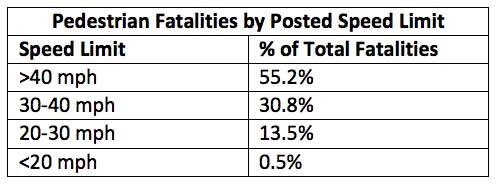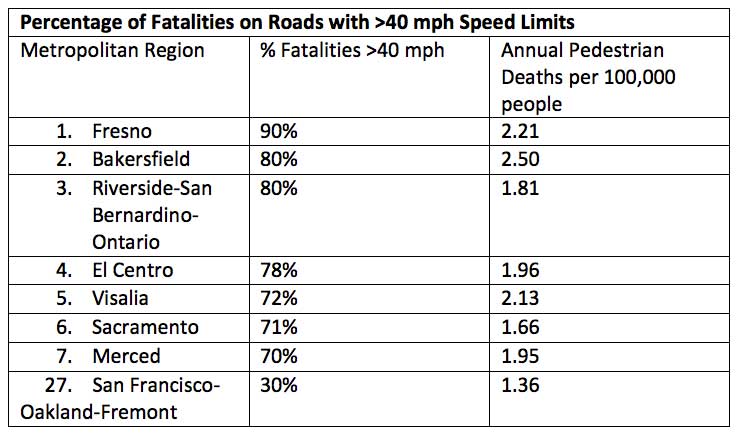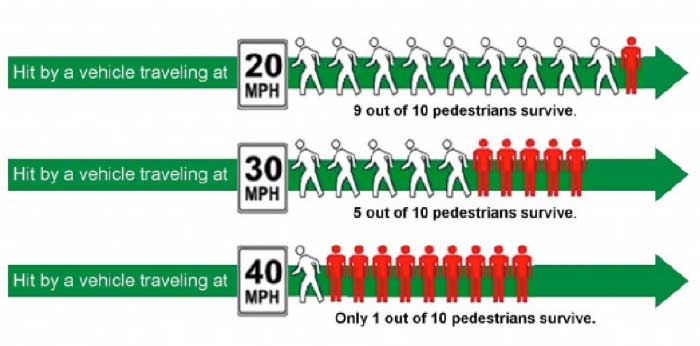As we’ve examined previously both here and here, the Dangerous by Design 2014 report contains a wealth of valuable information on the pedestrian safety crisis in the United States. One of the most striking aspects of the report is the clear connection drawn between speeding and pedestrian deaths. Consider the breakdown of pedestrian fatalities by posted speed limit:

The overarching message of this data is speed kills. More than half of all pedestrian fatalities occur on roads with speed limits greater than 40 mph, and 86 percent occur on roads with speed limits greater than 30 mph (keep in mind that speed limits are often exceeded). In contrast, only 13.5 percent of pedestrian fatalities occur on streets with speed limits less than 30 mph, and 0.5 percent of pedestrian fatalities occur on streets with speed limits less than 20 mph. This data comes as no surprise: risk of death for pedestrians increases exponentially with speed.
A look into individual California metropolitan areas tells a more striking story:

Rates of pedestrian fatalities in Fresno and Bakersfield are 65 percent and 84 percent higher (respectively) compared to San Francisco-Oakland-Fremont despite significantly higher pedestrian volumes in San Francisco-Oakland-Fremont. 90 percent of these fatalities in Fresno and 80 percent of these fatalities in Bakersfield occur on streets with speed limits greater than 40 mph; in contrast, only 30 percent of fatalities occur in San Francisco-Oakland-Fremont on similarly fast roads (an even lower percentage would likely occur for the urban core of San Francisco-Oakland-Berkeley). This data points to the failure of traffic engineering over the last few decades: Fresno, Bakersfield, and others on this list have developed grids of arterials that focus on speed over safety, and as a result are incredibly dangerous environments for pedestrians. The terrible irony is that many of these regions are among the youngest and poorest in the state; many youth and low-income residents depend on walking to get around.
Streets designed with speed limits of over 40 mph are fundamentally designed dangerously. When placed in urban and suburban areas, these roadways pose a threat to anyone who is not driving and do not comply with California’s statewide complete streets policy (AB 1358, PDF). Yet these fast arterials continue to be commonplace throughout California cities and an acceptable design in Caltrans’ Highway Design Manual. This is the tragic message of Dangerous by Design: we have the tools to design streets safely, but we chose not to—instead, we value speed and efficiency for automobiles, and are willing to accept people dying as a necessary cost. Is it worth it?
Alarming increase in pedestrian deaths in the United States
The Governors Highway Safety Association (GHSA) recently released a new report detailing the state of pedestrian safety across the United States. The report analyzed data from 2021, finding that an estimated 7,485 pedestrians lost their lives as a result of motor vehicle collisions, making it the deadliest year for pedestrians in four decades. Additionally, a shocking statistic revealed by the National Highway Traffic Safety Administration (NHTSA) showed that the percentage of speeding-related pedestrian crashes involving children under 15 more than doubled in the previous three years.
The report also provided a detailed breakdown of the data on a state-by-state basis. With an increase of 12% in pedestrian deaths from the previous year, 2021 was a devastating year for pedestrian safety. According to the report, the fatality rate per 100,000 people increased to 2.26 in 2021, up from 2.02 in 2020. The report found that dangerous driving behaviors like speeding, distracted and impaired driving, and inadequate infrastructure all contributed to the increase in pedestrian deaths.
To reverse this trend and make walking safer for everyone, the GHSA recommended addressing the root causes of the pedestrian safety crisis. One potential solution is the holistic Safe System approach, which includes the following five elements:
- Safe people
- Safe roads
- Safe vehicles
- Safe speeds
- Post-crash care
The GHSA report provides examples of successful state programs that have implemented the Safe System approach to improve pedestrian safety. Furthermore, the report suggests concrete ways that each of the five elements can be implemented to better protect pedestrians and all road users.
In addition to analyzing data from 2021, the GHSA report also looked at trends in pedestrian safety from 2010 to 2020. The report found that the percentage of pedestrian fatalities involving speeding rose to 8.6% in 2020, up from 7.2% the year before. Moreover, the report showed that pedestrian fatalities increased by 54% over the past decade, while all other traffic fatalities increased by just 13%.
While the report noted that pedestrian fatalities fell by 8% in America’s ten largest cities in 2020 after years of increases, the reduction was likely due to the pandemic’s impact on mobility. Moreover, the report emphasized that pedestrians continue to account for 17% of all traffic deaths, compared to 13% in 2010.
The GHSA report also found that passenger cars continue to account for the highest number of fatal pedestrian crashes. However, the number of pedestrian deaths in crashes involving sport utility vehicles (SUVs) increased at a faster rate than deaths in crashes involving passenger cars – 36% versus 27%, respectively. SUVs can cause more damage to pedestrians due to their greater weight and larger profile.
The GHSA report concluded that addressing the pedestrian safety crisis requires the implementation of the Safe System approach and other effective interventions. Furthermore, it is crucial to continue studying pedestrian safety data to better understand trends, patterns, and risk factors. Only then can effective strategies be developed to make walking safer for everyone.
In conclusion, the GHSA report highlights the pressing need to prioritize pedestrian safety. Dangerous driver behaviors and inadequate infrastructure continue to pose a significant threat to pedestrians across the United States. Policymakers, law enforcement, and communities must work together to address the root causes of the pedestrian safety crisis and create safer roads and walkways for all.




 AI-search
AI-search  Email
Email